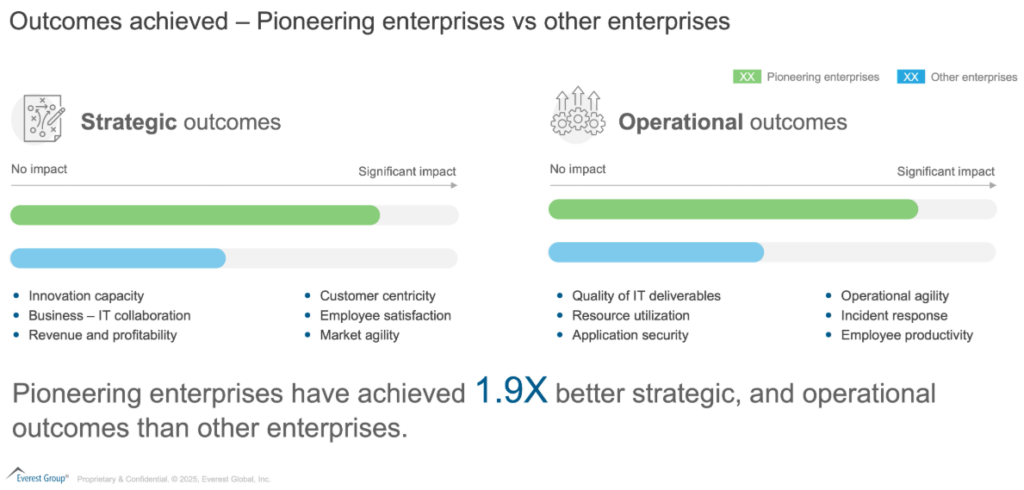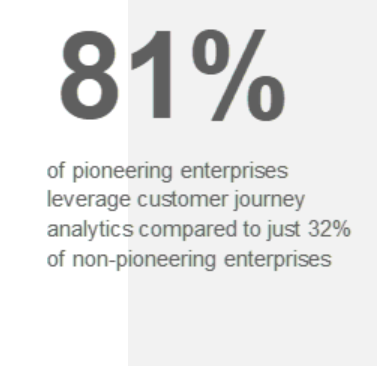Breaking the Product-led Operating Model (PLOM) Barrier: Why Some Enterprises Succeed While Others Stall? | Blog

This is the third blog in our series exploring the Product-Led Operating Model (PLOM). Our previous articles examined why enterprises should embrace PLOM as a competitive necessity and outlined four key strategies for successful transformation.
Now, we turn to perhaps the most crucial question: What sets the pioneers apart from those still struggling to realize PLOM’s full potential?
Although many enterprises understand the benefits of PLOM, very few have been able to graduate to a mature or pioneering state in their PLOM transformation journey. However, those that have successfully transitioned are reaping significantly higher benefits, as we outline below.
Reach out to discuss this topic in depth.
The reality check: A widening gap
The stark reality of PLOM implementation reveals a surprising truth: out of 200 enterprises surveyed, only 5-6% have successfully graduated to a mature PLOM state. These pioneers aren’t just checking boxes either — they’re achieving ~1.9X better outcomes across both strategic and operational metrics.
Meanwhile, 95% of enterprises find themselves at various stages of their transformation journey, with 35% still confined to applying PLOM principles only to new Information Technology (IT) projects, while managing their legacy systems through traditional approaches.
The pioneers of PLOM transformation are now experiencing unprecedented success across both strategic and operational dimensions. Their achievements span multiple areas critical to business success:
Strategic outcomes: A 2X advantage over others
The most successful organizations have fundamentally transformed their ability to innovate, collaborate, and compete in today’s dynamic market landscape. They’ve created environments that foster breakthrough ideas, accelerating time-to-market for innovative solutions. Through improved business-IT collaboration, these organizations have reduced friction and improved alignment, enabling faster decision-making and more effective execution.
Pioneering enterprises see twice the impact in key strategic areas such as innovation capacity, business-IT collaboration, revenue, and profitability. They have enhanced their market agility, allowing them to respond faster to changing conditions, and have significantly improved customer centricity and employee satisfaction. The ability to align IT with business priorities ensures that these enterprises remain ahead of the curve. Their enhanced market agility allows them to adapt swiftly to changing customer needs and market conditions, giving them a decisive competitive edge.

Operational Outcomes: A 1.75X performance boost
Beyond the strategic wins, these organizations have revolutionized their operational capabilities. On the operational front, pioneering enterprises have achieved a 1.75X better performance in areas such as IT deliverable quality, resource utilization, application security, and operational agility.
Their ability to optimize workflows, respond to incidents efficiently, and improve employee productivity has resulted in tangible gains that significantly outweigh their peers who have yet to fully transition to PLOM.
With streamlined processes and integrated feedback loops, product quality has skyrocketed. They’ve optimized resource utilization by focusing on value streams rather than isolated projects, leading to a 25% reduction in operational costs. Their commitment to DevOps practices has dramatically improved incident response times too, thus, minimizing system downtime and enhancing reliability.
The pioneer’s playbook: Four critical success factors
This disparity raises critical questions: What’s holding organizations back? More importantly, what are these 5-6% pioneering enterprises doing differently to achieve such remarkable results?
Our research reveals four fundamental approaches that distinguish PLOM leaders:
1. Breaking down organizational barriers
Successful organizations have moved beyond traditional structures that often impede progress.

They’ve introduced pivotal roles like product owners and product managers who bridge technical teams and business objectives, ensuring alignment between technical capabilities and business goals.
These organizations have also streamlined governance to empower teams with decision-making authority. Rather than maintaining the traditional model where IT serves as an advisor to the business, they’ve created integrated decision-making frameworks that ensure both groups share authority and responsibility for outcomes. This shift has proven crucial for accelerating decision-making and ensuring technology solutions truly align with business needs.
“46% of pioneering enterprises have cross-functional, self-organizing teams, while only 16% of non-pioneering enterprises have achieved this.”
2. Customer-centricity in action
Leading organizations have embedded customer focus into their DNA, moving beyond mere lip service to customer-centricity. They leverage artificial intelligence (AI)-driven insights and continuous feedback loops to inform product decisions. Through systematic customer journey mapping and rapid Minimum Viable Product (MVP) testing, they ensure every development decision aligns with real customer needs.
“Our research shows that only 37% of organizations effectively utilize innovation challenges and hackathons to generate customer-driven solutions.”
The pioneers, however, have made experimentation and innovation central to their operating model. They’ve established robust mechanisms for incorporating customer feedback into their product development cycle, ensuring their solutions address real market needs rather than perceived ones.

3. Embedding a culture of continuous improvement
PLOM leaders view transformation as an ongoing journey rather than a destination. While 53% of enterprises have implemented agile practices in select areas, pioneers have embedded these principles consistently across their entire organization.
They’ve fostered environments where experimentation thrives, and failure is viewed as a steppingstone to success. These organizations have also embraced modern engineering practices like Site Reliability Engineering (SRE) more comprehensively than their peers.
“While 48% of organizations have only moderately adopted SRE practices, leading organizations have fully integrated these approaches into their operations.”
They’ve established robust feedback loops from customers and stakeholders to refine product strategies in real-time and invested heavily in upskilling employees to meet the technical and cultural demands of a product-led transformation.
4. Value stream focus
Perhaps most critically, successful organizations have shifted from project-based thinking to value stream orientation.
“While 52% of enterprises still rely on traditional funding models, pioneers have embraced a product-oriented approach to funding and governance.”
They prioritize sustained product investments over short-term project funding and tie every decision to measurable business outcomes. Through OKRs (Objectives and Key Results), they ensure teams remain aligned around common goals, while maintaining the flexibility to adapt to changing market needs. This approach has enabled them to identify and eliminate bottlenecks more effectively, optimize resource allocation, and deliver continuous value to customers.
The path forward…
The achievements of these 5-6% pioneering enterprises sets a clear benchmark for the industry. Their success demonstrates that while the PLOM transformation journey is challenging, the rewards are substantial and measurable. For the 95% enterprises still working to unlock PLOM’s full potential, the path forward requires more than technical changes — it demands a fundamental transformation in how they approach value creation.
The message is clear: the gap between leaders and followers is widening, and the cost of delayed transformation grows daily. The pioneers have shown what’s possible through their commitment to breaking down silos, embedding customer-centricity, reinforcing continuous improvement, and redefining their approach to value creation.
As we conclude this series, we leave you with a critical question: Is your enterprise ready to join the ranks of these pioneering organizations, or will you risk being left behind as the market continues to evolve? The clock is ticking, and the time to act is now.
If you found this blog interesting, check out our Product-Led Transformation: Four Strategies To Outmaneuver Your Competition | Blog – Everest Group, which delves deeper into another topic regarding PLOM.
To discuss PLOM in more depth with our team, please contact Krishna Zawar ([email protected]), Parul Trivedi ([email protected]), Ankit Nath ([email protected]) and Lalith Kumar ([email protected])